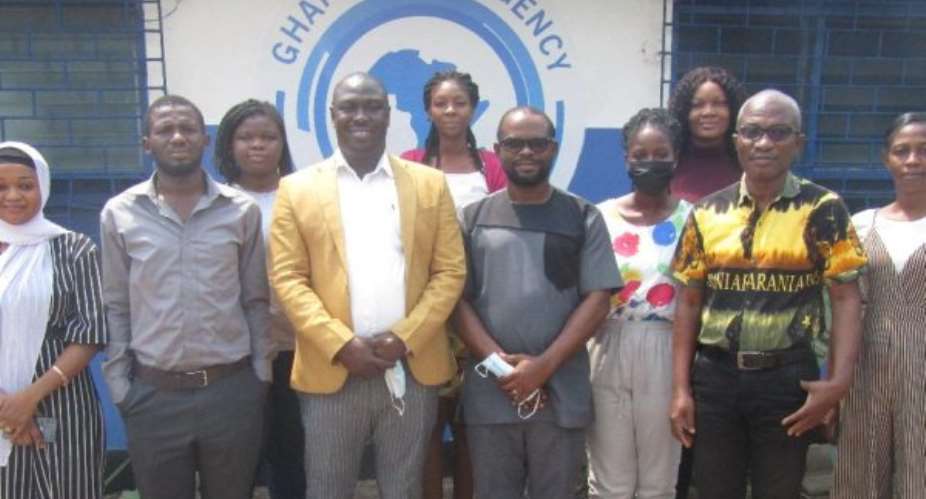Dr Kwame Oben-Nyarko an optometrist called on the public to join the campaign to fight avoidable blindness and visual impairment.
He said: “Globally, it is estimated that 2.3 billion people have refractive errors; out of this number, 670 million have visual impairment due to uncorrected refractive errors.
“In Ghana, it is estimated that 44 percent of all forms of visual impairment is caused by refractive errors and this is estimated to rise if the government does not invest in training and engaging the services of more optometrists as well as making lenses and frames more affordable by taking taxes off them”.
Dr. Oben-Nyarko who is the Chief Executive Officer of Third Eye Care and Vision Centre gave the advice at the third series of Ghana News Agency-Tema Regional Office and the Ghana Optometric Association fortnightly public sensitization initiative “GNA-GOA: My Eye! My Vision! and commended the Ghana News Agency Tema Regional Office for the partnership.
The fortnight initiative is a collaborative public education advocacy campaign to promote the need for people to access eye care and to draw attention to vision health.
The GNA-GOA: My Eyes! My Vision! The initiative also seeks to challenge the public and policymakers to focus on vision as a health issue, which forms a critical component of mankind's wellbeing but is often neglected.
Speaking on: “Acquiring a pair of spectacles: What you need to know,” Dr Oben-Nyarko said refractive error can simply be defined as the eyes' inability to focus all the light entering it to one point on the retina such that images become blurred.
It can either be caused by the eyeball being shorter or longer than it is supposed to be the power of the eye being either stronger or weaker than it is supposed to be or the curvature of the eyeball being irregular than it is supposed to be.
Dr Oben-Nyarko explained that there are three main types of refractive errors namely myopia (short-sightedness), hyperopia (farsightedness), and astigmatism.
He said there are other complex forms of refractive errors, and these could come in the form of myopia being combined with astigmatism or hyperopia being combined with astigmatism.
“All of these forms of refractive errors are characterized by blurriness of vision at either far (long) distances or near (short) distances. Refractive errors could lead to pain in the eyes as well as severe headaches that do not resolve with pain killers.
“Some patients of refractive errors also tend to strain or squint the eyes a lot and could also complain of seeing shadows around objects that they are looking at. This condition is simply managed using spectacle or contact lenses or laser surgery,” he said.
Dr Oben-Nyarko warned that it is never too early to wear glasses as failing to do so could lead to permanent visual impairment.
“This is a condition that affects people of all ages, and it is very worrying for children in school to have it because it tends to affect their performance due to their inability to see well and appreciate the detail.
“A lot of the time, if this condition is not diagnosed and managed early could lead to the eyes being permanently unable to see well even with spectacles,” he said.
Mr Francis Ameyibor, GNA-Tema Regional Manager explained that the two professional bodies have agreed to work together on a public sensitization campaign dubbed: “GNA-GOA: My Eyes! My Vision” to draw attention to vision health.
“We are combining the forces of our professional calling as Optometric Physicians and Communication Experts to reach out to the public with a well-coordinated message.
GNA





 E-Cedi will be used as a weapon to fight money laundering and corruption — Bawum...
E-Cedi will be used as a weapon to fight money laundering and corruption — Bawum...
 Election 20204: Transfer power to us peacefully for your own good — NDC tells NP...
Election 20204: Transfer power to us peacefully for your own good — NDC tells NP...
 Voter registration: Don't bus minors to registration centres — Nana Akomea warn ...
Voter registration: Don't bus minors to registration centres — Nana Akomea warn ...
 Error in registration slip: Trust the Commission on its mandate — EC assure Ghan...
Error in registration slip: Trust the Commission on its mandate — EC assure Ghan...
 Ejisu by-election: NPP aspirant who projected less than 5% votes for Aduomi cong...
Ejisu by-election: NPP aspirant who projected less than 5% votes for Aduomi cong...
 Election 2024: Stolen BVR kits could be used to illegally register people – NDC ...
Election 2024: Stolen BVR kits could be used to illegally register people – NDC ...
 60% of SHSs taken off double track system – Dr Yaw Osei Adutwum
60% of SHSs taken off double track system – Dr Yaw Osei Adutwum
 Voter registration: We hope to hit over one million registered voters in Volta -...
Voter registration: We hope to hit over one million registered voters in Volta -...
 Akufo-Addo not obliged to disclose full KPMG audit report – Presidency
Akufo-Addo not obliged to disclose full KPMG audit report – Presidency
 ECG staff used ransomware to sabotage paperless system, can you imagine they eve...
ECG staff used ransomware to sabotage paperless system, can you imagine they eve...
